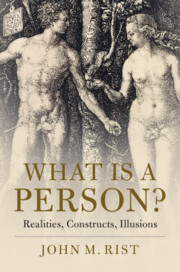Book contents
- What is a Person?
- What is a Person?
- Copyright page
- Contents
- Acknowledgments
- Introduction
- Part I Constructing the ‘Mainline Tradition’
- 1 The First Foundations: Plato and Aristotle
- 2 From Stoic Individuals and Personae to Christian Persons
- 3 Mixtures: Plotinus, Porphyry, Nemesius
- 4 Augustine’s Personae: Theology, Metaphysics, History
- 5 The Definition: Boethius and Richard of Saint Victor
- 6 Toward a Synthesis: Thomas Aquinas
- 7 Between Two Worlds: Duns Scotus
- Part II No God, no Soul: What Person?
- Part III Toward Disabling the Person
- Part IV Persons Restored or Final Solution?
- Epilogue or Epitaph?
- Appendix The World of Rights Transformed Again
- Bibliography
- Index
7 - Between Two Worlds: Duns Scotus
from Part I - Constructing the ‘Mainline Tradition’
Published online by Cambridge University Press: 05 December 2019
- What is a Person?
- What is a Person?
- Copyright page
- Contents
- Acknowledgments
- Introduction
- Part I Constructing the ‘Mainline Tradition’
- 1 The First Foundations: Plato and Aristotle
- 2 From Stoic Individuals and Personae to Christian Persons
- 3 Mixtures: Plotinus, Porphyry, Nemesius
- 4 Augustine’s Personae: Theology, Metaphysics, History
- 5 The Definition: Boethius and Richard of Saint Victor
- 6 Toward a Synthesis: Thomas Aquinas
- 7 Between Two Worlds: Duns Scotus
- Part II No God, no Soul: What Person?
- Part III Toward Disabling the Person
- Part IV Persons Restored or Final Solution?
- Epilogue or Epitaph?
- Appendix The World of Rights Transformed Again
- Bibliography
- Index
Summary
Up to this point we have been tracing, in broad outline, the development of a concept of the human person as a unique and uniquely dignified individual composite of body and soul. And we have attended to the Christian thesis that man is created in the image and likeness of God, recognizing it as the justification of that intrinsic dignity which we all share, whatever our social ‘estate’. In the second part of this study I shall argue that in the early modern period what I have called the Mainline Tradition was widely, if with some hesitation, abandoned: not least because beliefs about God and the soul – essential preconditions for its further development – were being discarded. We shall have to ask whether that discarding implied that earlier beliefs about human dignity could intelligibly be retained – or whether alternative justifications of our status and worth were perhaps identified, bearing in mind that even if alternatives fail to preserve our intrinsic worth, it does not follow that the Mainline Tradition is fit for that purpose.
- Type
- Chapter
- Information
- What is a Person?Realities, Constructs, Illusions, pp. 70 - 76Publisher: Cambridge University PressPrint publication year: 2019

